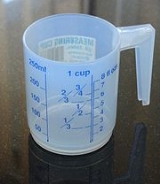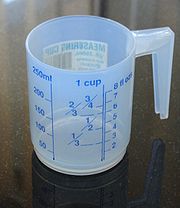
Measuring cup
Encyclopedia

Volume
Volume is the quantity of three-dimensional space enclosed by some closed boundary, for example, the space that a substance or shape occupies or contains....
of liquid or bulk solid cooking
Cooking
Cooking is the process of preparing food by use of heat. Cooking techniques and ingredients vary widely across the world, reflecting unique environmental, economic, and cultural traditions. Cooks themselves also vary widely in skill and training...
ingredients such as flour and sugar, especially for volumes from about 50 mL (2 fl oz
Fluid ounce
A fluid ounce is a unit of volume equal to about 28.4 mL in the imperial system or about 29.6 mL in the US system. The fluid ounce is distinct from the ounce, which measures mass...
) upwards. The cup will usually have a scale marked in cups and fractions of a cup, and often with fluid measure and weight of a selection of dry foodstuffs. Measuring cups are also used to measure washing powder, liquid detergents or bleach, with a measuring cup not also used for food.
Measuring cups may be made of plastic
Plastic
A plastic material is any of a wide range of synthetic or semi-synthetic organic solids used in the manufacture of industrial products. Plastics are typically polymers of high molecular mass, and may contain other substances to improve performance and/or reduce production costs...
, glass, or metal. Maximum capacity usually ranges from
0.2 to 1 litre, though larger sizes are also available (for commercial use). Smaller measuring spoon
Measuring spoon
A measuring spoon is a spoon kitchen utensil used to measure an amount of an ingredient, either liquid or dry, when cooking. Measuring spoons may be made of plastic, metal, and other materials. They are available in many sizes, including teaspoon and tablespoon. In the U.S., a measuring spoon is...
s lack a scale and are filled and leveled to maximum capacity. Its mostly used to measure things such as flour, water, or any type of liquid.
Capacity and scale
Measuring cups usually have capacities from 250 ml (approx. 1 cup) to 1000 ml (approx. 4 cups = 2 pints = 1 quart), though larger sizes are also available (for commercial use). They usually have scale markings at different heights: the substance being measured is added to the cup until it reaches the wanted level. Dry measure cups without a scale are sometimes used, in sets typically of 1/4, 1/3, 1/2, and 1 cup. Transparent or translucent cups can be read from an external scale; metal ones only from a scale marked on the inside. There are different types of measuring cups, such as glass or/and plasticThe units may be millilitres or fractions of a litre, or (especially in the United States and Australia) the cup
Cup (unit)
The cup is a customary unit of measurement for volume, used in cooking to measure liquids and bulk foods such as granulated sugar...
and its fractions (typically 1/4, 1/3, 1/2, 2/3, and 3/4), pint
Pint
The pint is a unit of volume or capacity that was once used across much of Europe with values varying from state to state from less than half a litre to over one litre. Within continental Europe, the pint was replaced with the metric system during the nineteenth century...
s, and sometimes fluid ounces. Sometimes multiples of teaspoon
Teaspoon
A teaspoon, an item of cutlery, is a small spoon, commonly part of a silverware place setting, suitable for stirring and sipping the contents of a cup of tea or coffee...
s and tablespoon
Tablespoon
A tablespoon is a type of large spoon usually used for serving. A tablespoonful, the capacity of one tablespoon, is commonly used as a measure of volume in cooking...
s are included. There may also be scales for the approximate weight for particular substances, such as flour and sugar.
There are eight ounces in one cup (American measurement).
is the measure of capacity and volume:)
For dry measure
Many dry ingredients, such as granulated sugar, are not very compressible, so volume measures are consistent. Others, notably flour, are more variable. For example, 1 cup of all-purpose flour sifted into a cup and levelled weighs about 100 grams, whereas 1 cup of all-purpose flour scooped from its container and levelled weighs about 140 grams.Using a measuring cup to measure bulk foods which can be compressed to a variable degree such as chopped vegetables or shredded cheese leads to large measurement uncertainties. It is easier to chop down the units for a better measure.

